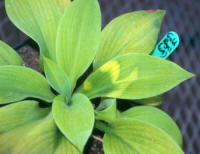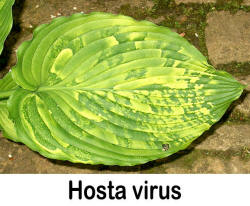 For
a long time, hostas were considered a "caste iron"
plant that had no serious problems other than deer
and slugs. Now that millions of gardens contain
hostas, people around the turn of the century, started noticing weird looking
plants. Upon laboratory analysis, many of these
plants were found to be infected by plant viruses.
Ugh!
For
a long time, hostas were considered a "caste iron"
plant that had no serious problems other than deer
and slugs. Now that millions of gardens contain
hostas, people around the turn of the century, started noticing weird looking
plants. Upon laboratory analysis, many of these
plants were found to be infected by plant viruses.
Ugh!
Bad News and Not So Bad News
- The bad news about plant viruses is that, once the
plant is infected, it cannot be cured. (Well, let's
say, that for all practical purposes, it
can't be cured. There are a few extremely tedious
propagation techniques which could create a new
plant from a tiny, uninfected part of the plant.)
There are no sprays or chemical treatments for a virus
problem.
Generally speaking,
the only recommendation for managing an infected
plant is to remove it from the garden and destroy
it. That can be expensive. That is why prevention is
the only practical course for stopping this problem
in your garden.
The not so bad news
is that virus infections do not necessarily mean the
death of the plant. Viral disease in plants usually
show themselves in mottled (yellow) streaks in the
leaves, distortion of leaves or other plant parts,
flower abortion or discoloration and loss of overall
vigor in the plant.
Another not so bad
news element is that viruses do not easily spread
through your garden.

How do viruses spread?
Fortunately, viruses are immobile "crystalline" type
of organisms. In other words, they don't have legs
or wings and cannot swim. They must rely on others
to move them around. Some plant viruses need the
help of sucking insects such as
aphids,
thrips or
leafhoppers to move them from plant to plant.
Others are transported on the surface of pruning
shears or hoes that cut one plant and then move on
to cut another plant. A few viruses can move in
splashing water from rain or irrigation causing a
splash that goes from one plant to another.
Do all hostas get viruses?
NO! Research to date indicates that some
hosta cultivars are susceptible, some are tolerant
of viral infection i.e. they may test positive for
the virus but show no symptoms and others appear to
be immune. Hostaphiles are in the process of
defining which cultivars belong to which group.
The American Hosta
Society has been helping to fund research on hosta
viruses by Dr. Ben Lockhart at the University of
Minnesota. Here is a summary of what he has found
out so far on several virus types found in hostas:




